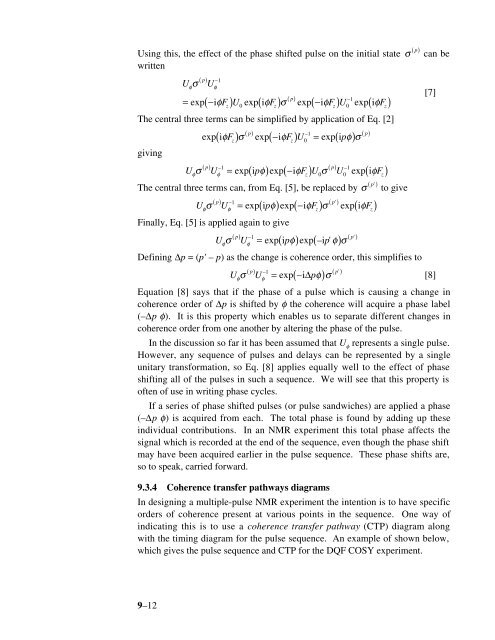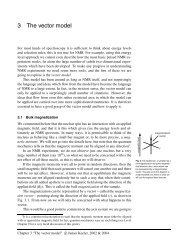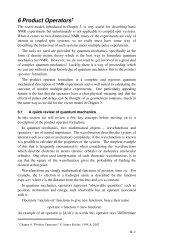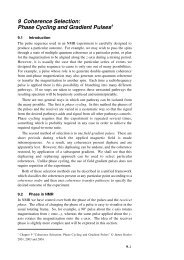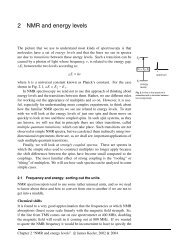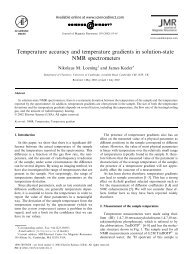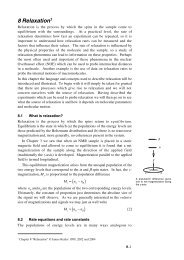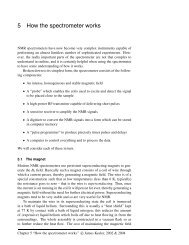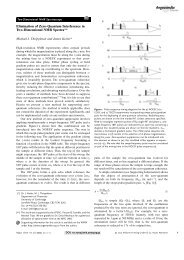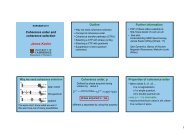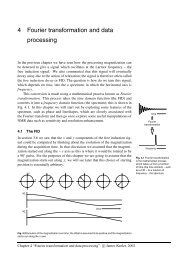Phase Cycling and Gradient Pulses - The James Keeler Group
Phase Cycling and Gradient Pulses - The James Keeler Group
Phase Cycling and Gradient Pulses - The James Keeler Group
You also want an ePaper? Increase the reach of your titles
YUMPU automatically turns print PDFs into web optimized ePapers that Google loves.
Using this, the effect of the phase shifted pulse on the initial state σ ( p)<br />
can be<br />
written<br />
U σ<br />
φ<br />
( p)<br />
– 1<br />
Uφ<br />
( ) ( )<br />
( )<br />
−<br />
( ) ( )<br />
p<br />
– 1<br />
= exp −iφFz<br />
U0exp iφFz<br />
σ exp iφFz<br />
U0<br />
exp iφFz<br />
<strong>The</strong> central three terms can be simplified by application of Eq. [2]<br />
giving<br />
( ) ( − ) = ( )<br />
p<br />
– 1<br />
exp iφF σ exp iφF U exp ipφ σ<br />
z<br />
( ) ( p)<br />
z 0<br />
( ) ( )<br />
( ) ( )<br />
p<br />
p<br />
Uφσ U – 1<br />
φ<br />
= ( pφ) − φFz<br />
U σ U – 1<br />
exp i exp i<br />
0 0<br />
exp iφFz<br />
<strong>The</strong> central three terms can, from Eq. [5], be replaced by σ ( p' ) to give<br />
( ) ( )<br />
φ<br />
z<br />
p<br />
p<br />
U σ U – 1<br />
= exp( ipφ) exp −iφF σ '<br />
exp iφF<br />
φ<br />
Finally, Eq. [5] is applied again to give<br />
( ) ( )<br />
( ) – ( p'<br />
)<br />
φ<br />
p 1<br />
U σ U exp i pφ exp –ip'<br />
φ σ<br />
φ<br />
= ( ) ( )<br />
Defining ∆p = (p' – p) as the change is coherence order, this simplifies to<br />
z<br />
[7]<br />
p – 1<br />
p'<br />
U σ U exp – i∆ pφ σ<br />
[8]<br />
φ<br />
( ) ( )<br />
φ<br />
= ( )<br />
Equation [8] says that if the phase of a pulse which is causing a change in<br />
coherence order of ∆p is shifted by φ the coherence will acquire a phase label<br />
(–∆p φ). It is this property which enables us to separate different changes in<br />
coherence order from one another by altering the phase of the pulse.<br />
In the discussion so far it has been assumed that U φ<br />
represents a single pulse.<br />
However, any sequence of pulses <strong>and</strong> delays can be represented by a single<br />
unitary transformation, so Eq. [8] applies equally well to the effect of phase<br />
shifting all of the pulses in such a sequence. We will see that this property is<br />
often of use in writing phase cycles.<br />
If a series of phase shifted pulses (or pulse s<strong>and</strong>wiches) are applied a phase<br />
(–∆p φ) is acquired from each. <strong>The</strong> total phase is found by adding up these<br />
individual contributions. In an NMR experiment this total phase affects the<br />
signal which is recorded at the end of the sequence, even though the phase shift<br />
may have been acquired earlier in the pulse sequence. <strong>The</strong>se phase shifts are,<br />
so to speak, carried forward.<br />
9.3.4 Coherence transfer pathways diagrams<br />
In designing a multiple-pulse NMR experiment the intention is to have specific<br />
orders of coherence present at various points in the sequence. One way of<br />
indicating this is to use a coherence transfer pathway (CTP) diagram along<br />
with the timing diagram for the pulse sequence. An example of shown below,<br />
which gives the pulse sequence <strong>and</strong> CTP for the DQF COSY experiment.<br />
9–12


